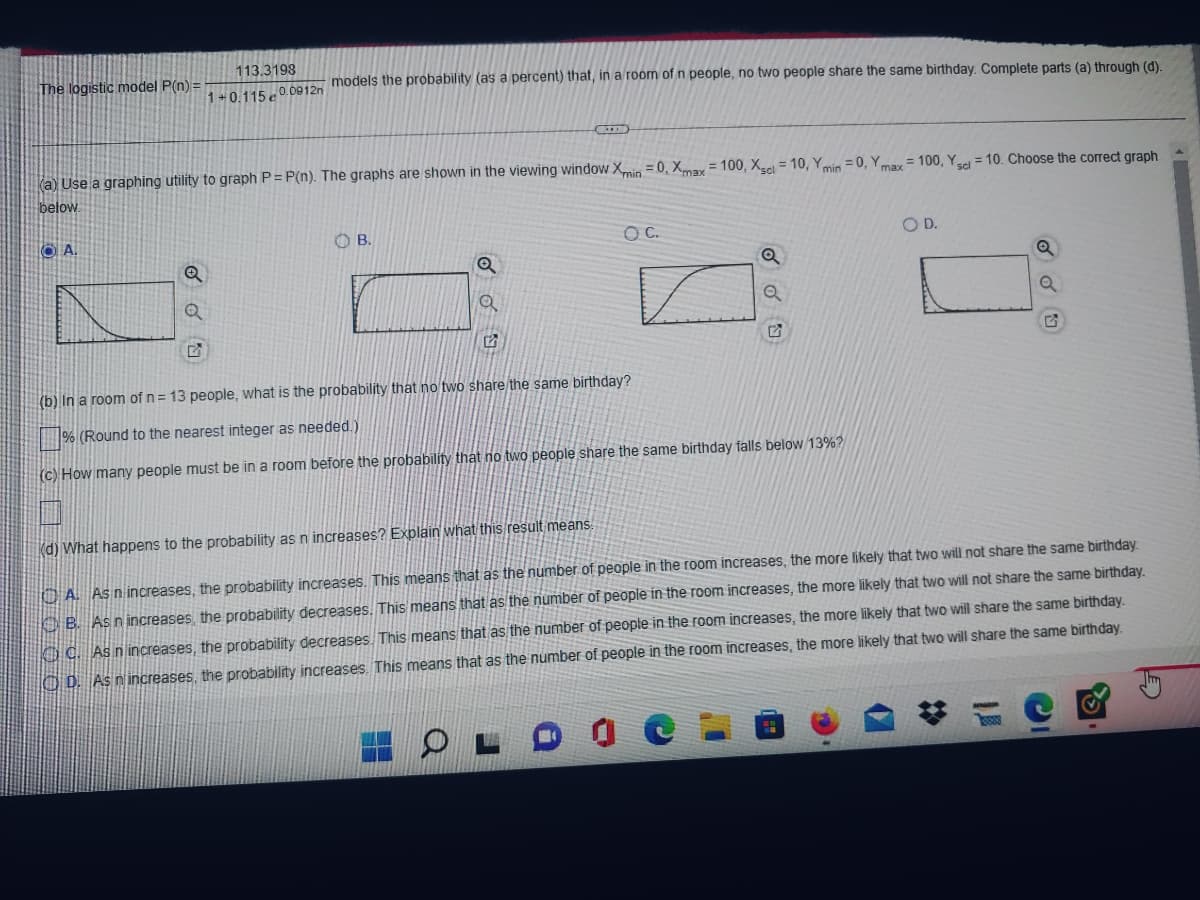The logistic model P(n) = OA. a) Use a graphing utility to graph P= P(n). The graphs are shown in the viewing window Xmin = 0, Xmax = 100, Xscl = 10, Ymin = 0, Ymax = 100, Ysel = 10. Choose the correct graph below. Q 113.3198 1+0.1150.0912n Q models the probability (as a percent) that, in a room of n people, no two people share the same birthday. Complete parts (a) through (d). B. Q a E OC. (b) In a room of n = 13 people, what is the probability that no two share the same birthday? (Round to the nearest integer as needed.) Q Q came birthday falls below 13%? OD. Q
The logistic model P(n) = OA. a) Use a graphing utility to graph P= P(n). The graphs are shown in the viewing window Xmin = 0, Xmax = 100, Xscl = 10, Ymin = 0, Ymax = 100, Ysel = 10. Choose the correct graph below. Q 113.3198 1+0.1150.0912n Q models the probability (as a percent) that, in a room of n people, no two people share the same birthday. Complete parts (a) through (d). B. Q a E OC. (b) In a room of n = 13 people, what is the probability that no two share the same birthday? (Round to the nearest integer as needed.) Q Q came birthday falls below 13%? OD. Q
Chapter6: Exponential And Logarithmic Functions
Section6.8: Fitting Exponential Models To Data
Problem 2TI: Sales of a video game released in the year 2000 took off at first, but then steadily slowed as time...
Related questions
Question

Transcribed Image Text:The logistic model P(n) =
113.3198
1+0.115 e 0.0912n models the probability (as a percent) that, in a room of n people, no two people share the same birthday. Complete parts (a) through (d).
(a) Use a graphing utility to graph P= P(n). The graphs are shown in the viewing window Xmin = 0, Xmax = 100, Xscl = 10, Ymin = 0, Ymax = 100, Yscl = 10. Choose the correct graph
below.
OA
Q
C
Q
B.
a
5
OC.
Q
(b) In a room of n = 13 people, what is the probability that no two share the same birthday?
% (Round to the nearest integer as needed.)
(c) How many people must be in a room before the probability that no two people share the same birthday falls below 13%?
O D.
Q
(d) What happens to the probability as n increases? Explain what this result means.
A. As n increases, the probability increases. This means that as the number of people in the room increases, the more likely that two will not share the same birthday.
B. As n increases, the probability decreases. This means that as the number of people in the room increases, the more likely that two will not share the same birthday.
C. As n increases, the probability decreases. This means that as the number of people in the room increases, the more likely that two will share the same birthday.
OD. As n increases, the probability increases. This means that as the number of people in the room increases, the more likely that two will share the same birthday.
Expert Solution
This question has been solved!
Explore an expertly crafted, step-by-step solution for a thorough understanding of key concepts.
This is a popular solution!
Trending now
This is a popular solution!
Step by step
Solved in 4 steps with 4 images

Recommended textbooks for you


Algebra & Trigonometry with Analytic Geometry
Algebra
ISBN:
9781133382119
Author:
Swokowski
Publisher:
Cengage


Algebra & Trigonometry with Analytic Geometry
Algebra
ISBN:
9781133382119
Author:
Swokowski
Publisher:
Cengage